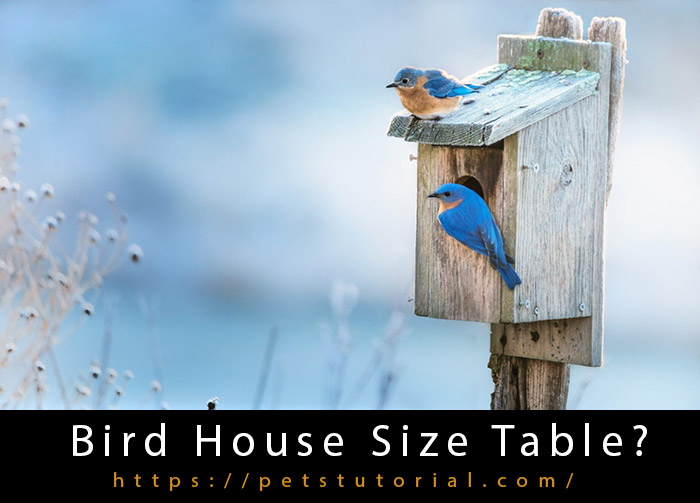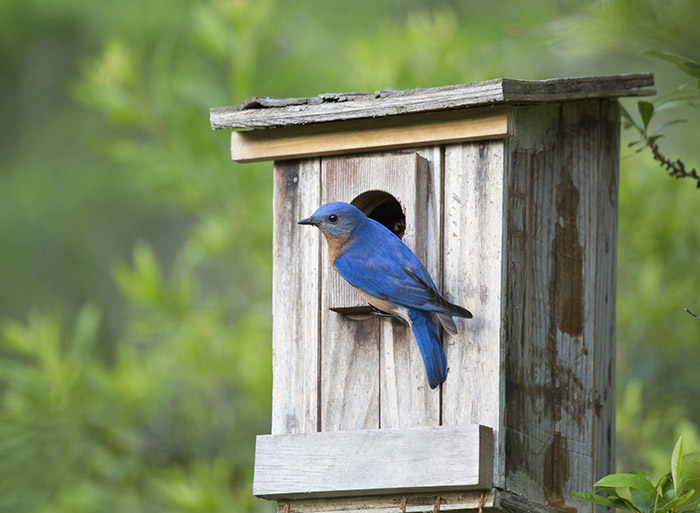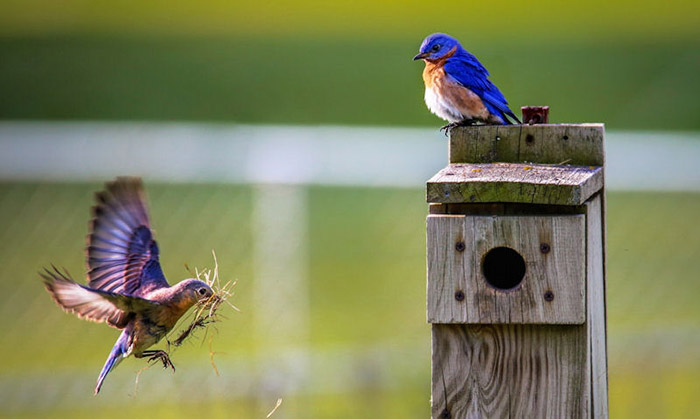The size of the bird house you need to build depends on the species you want to attract, but even if you know this, you can still wind up with unwanted visitors.
Even if you know the species of birds you want to attract, the size of your bird house’s floor will determine how tall your structure needs to be. When you do, you’ll have a much better idea of what kinds of birds you can expect to draw to your feeder. There is no standard size for bird houses, but getting it right is essential if you want to discourage invading species.
You are reading: Bird House Sizes That You Need Know
The size of the floor is the first consideration when planning to build or purchase a bird house, and from there the rest of the dimensions will fall into place.
The typical floor size for a Bluebird house is 4 by 4 inches, whereas the floor size for a Kestrel house is 8 by 8 inches.
This is important to know since different types of birds have different sizing needs, with the floor’s internal depth and width serving as a proxy for those needs.
If you read the label on a quality bird house, you’ll know that the floor space is designed for a certain species of bird.
In addition to the length, width, and height, the height of the bird house is an essential parameter.
Bird houses are typically 8 to 9 inches in height, while the standard Bluebird house is 10 inches in height (measured from the floor to the top of the front panel).
Even though the width of the floor is more crucial, the height of the box is still important because this is where the bird house entry hole will be carved out of.
Bird house size table

| Species: | Floor: | Height: | Width: | Depth: |
| American Kestrel | 8 x 8in | 16in | 8in | 8in |
| American Robin | 6 x 8in | 8in | 6in | 8in |
| Ash-Throated Flycatcher | 6 x 6in | 9in | 6in | 6in |
| Barn Owl | 36 x 23in | 24in | 36in | 23in |
| Barn Swallow | 6 x 6in | 6in | 6in | 6in |
| Barred Owl | 14 x 14in | 26in | 14in | 14in |
| Bewick’s Wren | 4 x 4in | 7in | 4in | 4in |
| Black-Capped Chickadee | 4 x 4in | 9in | 4in | 4in |
| Carolina Chickadee | 4 x 4in | 9in | 4in | 4in |
| Carolina Wren | 4 x 4in | 7in | 4in | 4in |
| Chestnut-Backed Chickadee | 4 x 4in | 9in | 4in | 4in |
| Downy Woodpecker | 4 x 4in | 9in | 4in | 4in |
| Eastern Bluebird | 4 x 4in | 10in | 4in | 4in |
| Eastern Phoebe | 6 x 6in | 6in | 6in | 6in |
| Eastern Screech-Owl | 8 x 8in | 16in | 8in | 8in |
| Eurasian Tree Sparrow | 4 x 4in | 10in | 4in | 4in |
| European Starling | 6 x 6in | 16in | 6in | 6in |
| Great-Crested Flycatcher | 6 x 6in | 9in | 6in | 6in |
| Hairy-Headed Woodpecker | 6 x 6in | 12in | 6in | 6in |
| House Finch | 5 x 5in | 8in | 5in | 5in |
| House Sparrow | 4 x 4in | 10in | 4in | 4in |
| House Wren | 4 x 4in | 7in | 4in | 4in |
| Juniper Titmouse | 4 x 4in | 9in | 4in | 4in |
| Mountain Bluebird | 4 x 4in | 10in | 4in | 4in |
| Mountain Chickadee | 4 x 4in | 9in | 4in | 4in |
| Northern Flicker | 7 x 7in | 17in | 7in | 7in |
| Purple Martin | 6 x 6in | 6in | 6in | 6in |
| Red-Bellied Woodpecker | 7 x 9in | 17in | 7in | 9in |
| Red-Breasted Nuthatch | 4 x 4in | 9in | 4in | 4in |
| Red-Headed Woodpecker | 6 x 6in | 14in | 6in | 6in |
| Prothonotary Warbler | 5 x 5in | 6in | 5in | 5in |
| Tree Swallow | 5 x 5in | 7in | 5in | 5in |
| Tufted Titmouse | 4 x 4in | 9in | 4in | 4in |
| Violet-Green Swallow | 5 x 5in | 8in | 5in | 5in |
| Western Bluebird | 4 x 4in | 10in | 4in | 4in |
| Wood Duck | 12 x 12in | 22in | 12in | 12in |
| White-Breasted Nuthatch | 4 x 4in | 9in | 4in | 4in |
Floor size critical
What matters most when constructing a bird home is the required size. A bluebird house, for instance, has to have a floor space of at least 4 inches by 4 inches.
The dimensions of a bird house are determined in large part by its floor size. To err here is to build a bird house that is either too large or too small for the species of birds you hope to attract.
Most typical backyard birds want a floor space that is identical in width and depth, so if you’re planning on building a birdhouse for them, plan on building one that’s exactly 4 inches wide and 4 inches deep.
In other words, the size of your floor will be sufficient to meet the needs of all but three of the bird species for whom I have detailed criteria in the chart above.
That being said, how big of a birdhouse do you think is ideal? must be planned only on the basis of floor space, as a larger home may entice more unwanted visitors, while a smaller one may successfully scare away any birds who might otherwise want to make a home in it.
Plan out the construction of the bird house, or use the floor area to determine which bird house to purchase; my table will help you choose the right one.
Front Height exactly

Read more : Discover Types Of Birds That Can Swim Underwater
The second most significant consideration after determining the floor area is the desired height of the bird house.
You’ll want to get this part right up front, as it will be the location of the spherical bird house entry hole.
Since the front of the birdhouse will dictate how tall the box needs to be, the width and depth will automatically adjust to fit.
A bluebird house, for instance, must have a front opening no more than 10 inches wide and a floor area of 4 square feet.
To build a birdhouse to specification, the height must be determined with precision.
Only at the back end can additional height be added; this is where the slope is required to direct water off the roof, thus an extra inch or two of height is required to provide this necessary angle.
Width to floor size
Achieving success in luring America’s preferred nesting birds to your box is as simple as making sure it’s the right size for those birds.
These measurements will be taken using only the most crucial internal measurements, so their width will roughly correspond to the width of the floor plan.
The inner dimensions of a Bluebird house are 4 square inches, and the external dimensions of a bird house’s side panels are also 4 square inches.
The front and back panels of a birdhouse are adjustable relative to the subfloor, allowing you to determine the thickness of the Cedar used for those panels by looking only at them.
Again, the dimensions of a Bluebird floor plan would be 4 by 4, and the dimensions of the front panel would be 4 inches wide and 10 inches high.
The width cut for the back panel is identical, but additional length is required for use as a screw area or, alternatively, for mounting to a tree for better ecological impact.
Depth still applies

The floor of the birdhouse that is home to the House Finch is five inches by five inches.
Because the width and depth of the internal box are inherited from the floor size, knowing this is crucial.
Since the floor is 5 feet by 5 feet, the depth is naturally 5 inches.
It’s important to account for the thickness of the Cedar when measuring depth, so the exterior measurements will be slightly larger than they would be without it.
Read more : Do Birds Eating Suet?
Since the front and back panels are already at the same level as the floor, this would make it such that the side panels could join them.
The Barn Owl, unsurprisingly, makes greater use of breadth than depth while building its nest, but this is not the case for the vast majority of birds that will use a box.
Error of margin acceptable
In the United States, the best bird houses are those designed to attract local bird species.
The dimensions of the floor, the ceiling, the walls, and the foundation all play a role in determining the optimal size of a bird house.
A margin of error exists, though, which is good news. This means that even if the box is only a hair too big or too small, it still has a good chance of luring in the desired species of bird.
The downside is that undesirable species, such starlings and house sparrows, may be drawn to your bird home to nest.
However, if you underestimate the size of the floor, you’ll have a lot of problems later on.
If the width and depth may be adjusted by a few millimeters, that’s fine, but the floor size must be precise within a half inch.
The height of the bird house is crucial, so make sure to consult the table providing this essential information; you’ll see that many species share the same height, which means the bird house can attract a wide variety of species.
Summarize it all up
The preferred nesting species can help determine the optimal bird house size.
The size of the floor of such a bird home would determine its overall dimensions. If you buy or construct this part correctly, the rest of the measurements will fall into place.
The ideal floor size for attracting bluebirds is 4 square inches, so a bluebird house should be 4 square inches in both width and depth.
Birds will only nest in bird houses that are somewhat tall, as measured from the front.
The bird house’s back piece must be mounted using the support back panel, which also serves to secure the back. This necessitates a bit more headroom in the rear. However, a roof angle is required, which necessitates a higher rear panel.
Small birds may find a box too huge, while a larger bird may not have enough area to stretch its wings, therefore bird houses must be constructed to a precise size internally.
Therefore, while height is crucial, width and depth are less so, because handmade bird houses largely inherit the size of the cavities birds utilize in the wild.
If you can nail down the ideal floor area, then furniture and accessories can be scaled down to fit.
Source: https://petstutorial.com
Category: Birds










